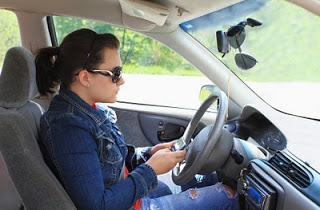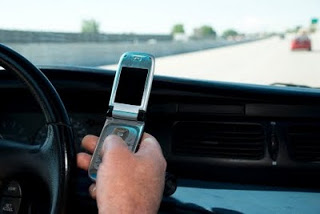Tag Archive: banning texting

Teens Texting More Than Ever
March 19, 2012
A recently released study by the Pew Research Center’s Internet and American Life Project shows that teens are texting more than ever and, it seems, they prefer texting to phone conversations. The findings don’t bode well for motor vehicle safety groups who are trying to spread the word about the dangers of texting and driving. The greater portion of the increase in texting by teens falls in the age group of those just beginning to drive.
The study’ authors conducted phone interviews in both in English and in Spanish with a “nationally representative sample of 799 teens ages 12 to 17 years old and their parents living in the continental United States” in 2011. They found that texting is the “dominant daily mode of communication between teens and all those with whom they communicate.” Here is some of the information revealed in the study:
- “Overall, 77% of those ages 12-17 have a cell phone. The percentage of younger teens ages 12 and 13 with cell phones has declined slightly since 2009
- The frequency of teens’ phone chatter with friends – on cell phones and landlines – has fallen
- The typical American teen is sending and receiving a greater number of texts than in 2009. Overall, 75% of all teens text.
- The median number of texts (i.e. the midpoint user in our sample) sent on a typical day by teens 12-17 rose from 50 in 2009 to 60 in 2011.
- Much of this increase occurred among older teens ages 14-17, who went from a median of 60 texts a day to a median of 100 two years later. Boys of all ages also increased their texting volume from a median of 30 texts daily in 2009 to 50 texts in 2011. Black teens showed an increase of a median of 60 texts per day to 80.
- Older girls remain the most enthusiastic texters, with a median of 100 texts a day in 2011, compared with 50 for boys the same age.
- 63% of all teens say they exchange text messages every day with people in their lives. This far surpasses the frequency with which they pick other forms of daily communication, including phone calling by cell phone (39% do that with others every day), face-to-face socializing outside of school (35%), social network site messaging (29%), instant messaging (22%), talking on landlines (19%) and emailing (6%).
- The heaviest texters (those who exchange more than 100 texts a day) are much more likely than lighter texters to say that they talk on their cell phone daily. Some 69% of heavy texters talk daily on their cell phones, compared with 46% of medium texters (those exchanging 21-100 texts a day) and 43% of light texters (those exchanging 0-20 texts a day).
- Some 23% of all those ages 12-17 say they have a smartphone and ownership is highest among older teens: 31% of those ages 14-17 have a smartphone, compared with just 8% of youth ages 12-13. There are no differences in ownership of smartphones versus regular cell phones by race.”

Distracted Driving Campaigns
July 9, 2010
Buzz, buzz…it will just take a second to check. Ring, ring…it could be important. Yeah, I should go ahead and make that call. It will save me the time and hassle later on. The temptation to reach out and/or respond to some one through a cell phone is great. You have heard the news stories and safe driving campaigns and you know that you shouldn’t, but…do you resist the urge to use the cell phone or let temptation get the best of you?
In order to completely eliminate the urge to use your phone you could turn it off before turning your key in the ignition, lock it up (in the glove box, console, or trunk), or install some of the new technology for cell phones. There are several companies offering services that will restrict the phone’s ability to send and receive text and email messages. Some companies offer services that will restrict calls too. A sampling include:
Textecution – http://www.textecution.com
Textecution is an application designed for parents to install on their children’s phones. It utilizes the GPS features of several handsets to determine if the owner of the phone is moving at more than 10mph. It disables the texting function of the phone. If the person with Textecution on their phone is riding a vehicle as a passenger, or in a bus or train need to use the text feature, there is an “override” option — requesting for text access from the administrator. The parent who installed the phone is designated as the administrator, and can allow, temporarily for the phone to allow texting features. www.safefloridadriver.com
iZUP – http://www.getizup.com/
iZUP disables your phone entirely, removing any distraction from the road. It automatically forwards calls to voicemail and holds text messages while the phone is in motion. It is also time-delayed, to prevent reactivation of the phone’s features in natural stopping areas, like stop lights. The phone will only allow the user to make calls to 911 and 3 pre-approved numbers.
TXTBlocker – http://www.txtblocker.com/
TXTBlocker utilizes GPS locations to detect if the phone is traveling at a car’s moving rate and disables features of the phone accordingly. The installer of the TXTBlocker phone can also designate which areas are no-phone zones, and deactivates texting, calling, email and browsing. There’s also a feature that auto sends a text message to the parent, should the phone be moving at speeds greater than 65mph. Another safety feature for parents is they could check where the owner of the phone is in, based on GPS location. The phone will still be able to dial 911, in case of emergency. It only checks in with GPS every few minutes, so it doesn’t constantly use the phone’s battery.
DriveSafe.ly – http://www.drivesafe.ly/
DriveSafe.ly is a hands-free application that reads out text messages and emails as the phone receives it. There is an optional auto-responder that sends out a customized text message while the application is active.
Committing to be distraction free when you are driving is not easy. But the statistics remind us each day that we are more likely to have a collision when we are distracted, many drivers are making an effort. Regardless of whether it is hand held or hands free, the cell phone is a distraction for every driver.
Learn more about the Measures Taken to Stop Distracted Driving.

Coming Soon, Texting your Way to a Fine
July 24, 2007
Quite a few states have jumped on the bandwagon about banning driving while talking on the cell phone. However, the growing trend of texting while driving has caused lawmakers, especially in New York to go back to the drawing board to include texting in that ban. And after the recent fatal accident where five teens were killed, with texting as a likely culprit, the heat is really on to get the new ruling passed.
The question remains, “Will a ban on texting really help prevent accidents?” No one really knows for sure and as a result, the proposed law change is getting some mixed reviews. Some people feel that the wireless industry is not doing enough to advertise the dangers of cell phone use while driving. However, others feel that it all boils down to practicing basic defensive driving skills.
People hear that talking on the cell phone and texting has caused accidents and killed people, yet they do not hinder their own actions. Why is that? It’s just like smoking. You know that it is hazardous to your health, yet you do it anyway. The same principle applies with cell phones. Are our lives so busy and competitive that we cannot miss a single moment with our cell phones? How did we ever get along twenty or thirty years ago?
Another part of the problem is how to keep the teenagers from texting while driving. Many of them admit to doing it and know it is dangerous and still do it anyway. At some point, we have to accept responsibility for ourselves. In the case of teenagers who are still feeling their way around the whole driving thing, the parents are going to have to be the guiding force in appropriate driving behavior in teens. Of course, that means that they will have to clean up their own acts so that they can lead by example.
It is because people know better yet do it anyway that is precipitating this texting inclusion in the existing cell phone law. Sometimes, we have to help those who refuse to help themselves. And if it takes imposing fines to get the point across, so be it. The problem is that no one truly knows how much of an impact this law will make on saving lives. We’ll just have to wait and see.

